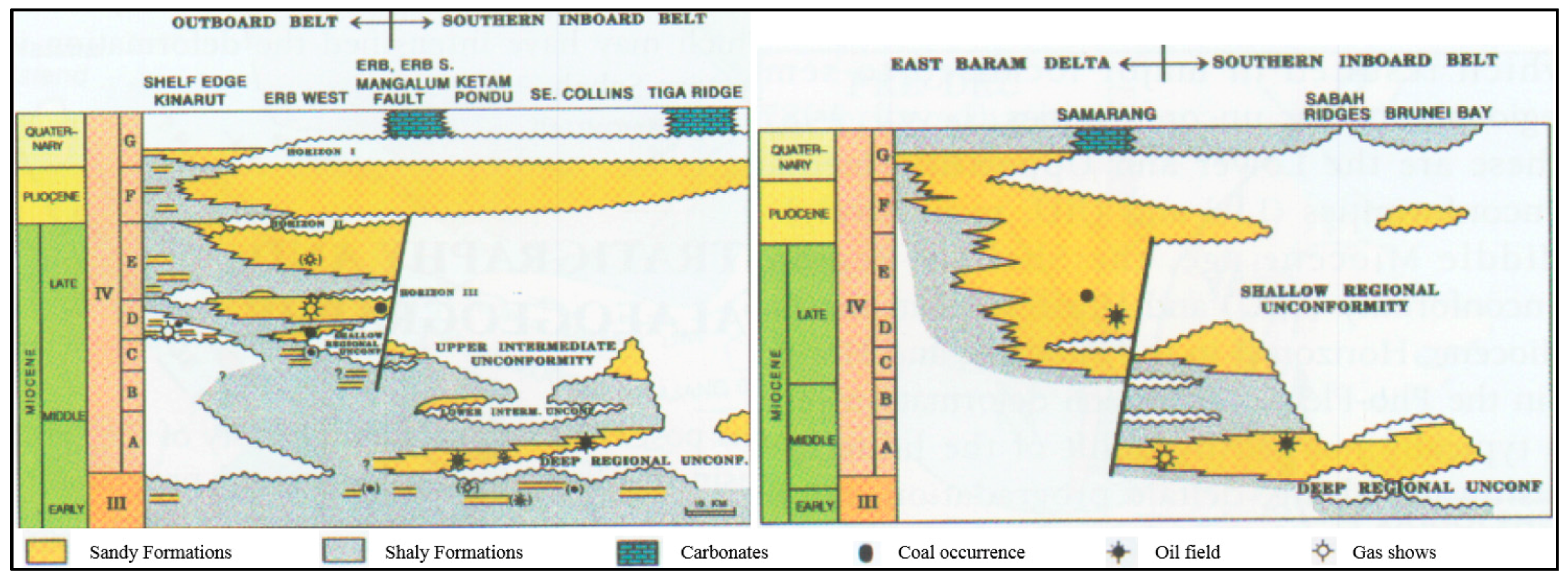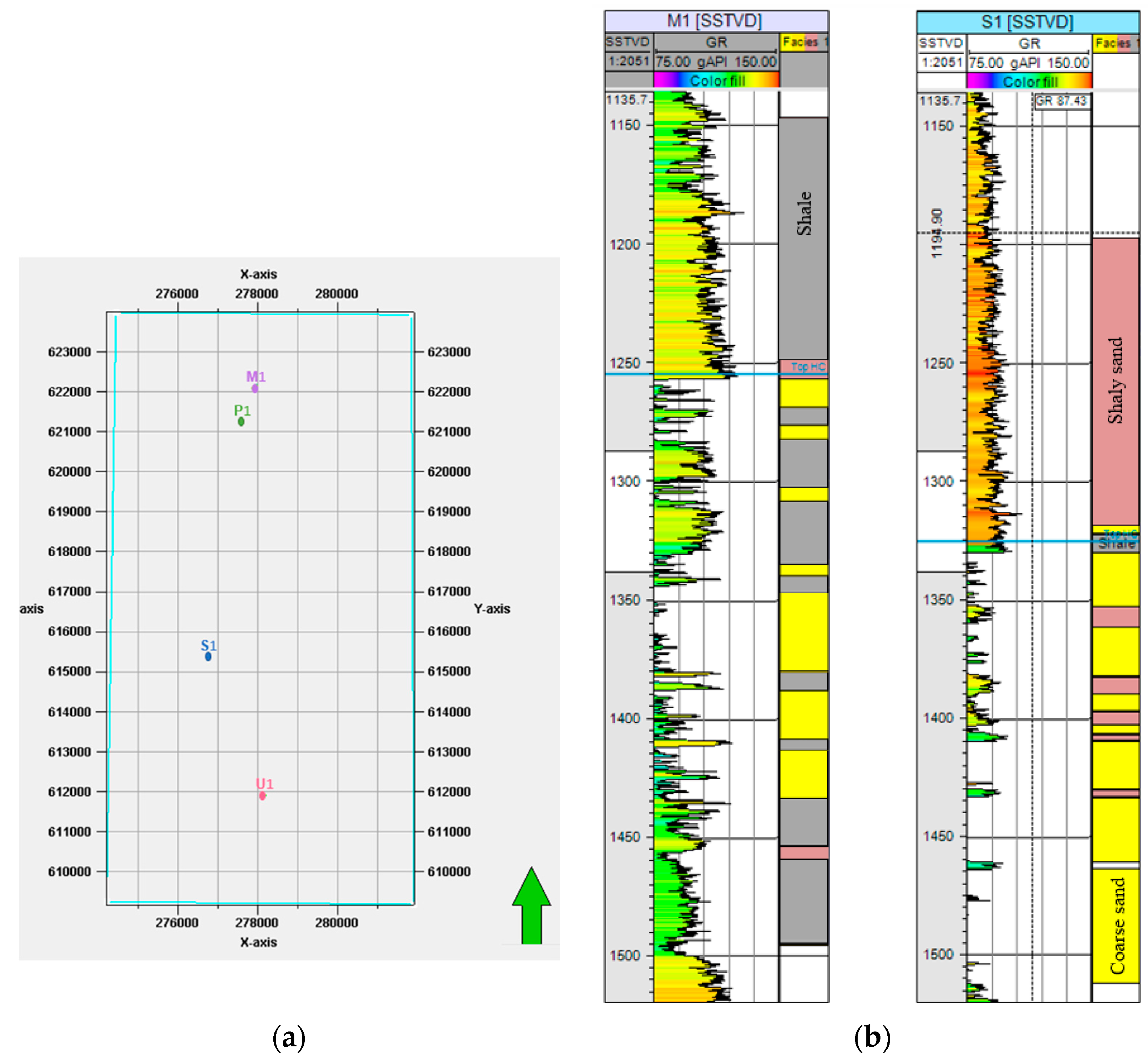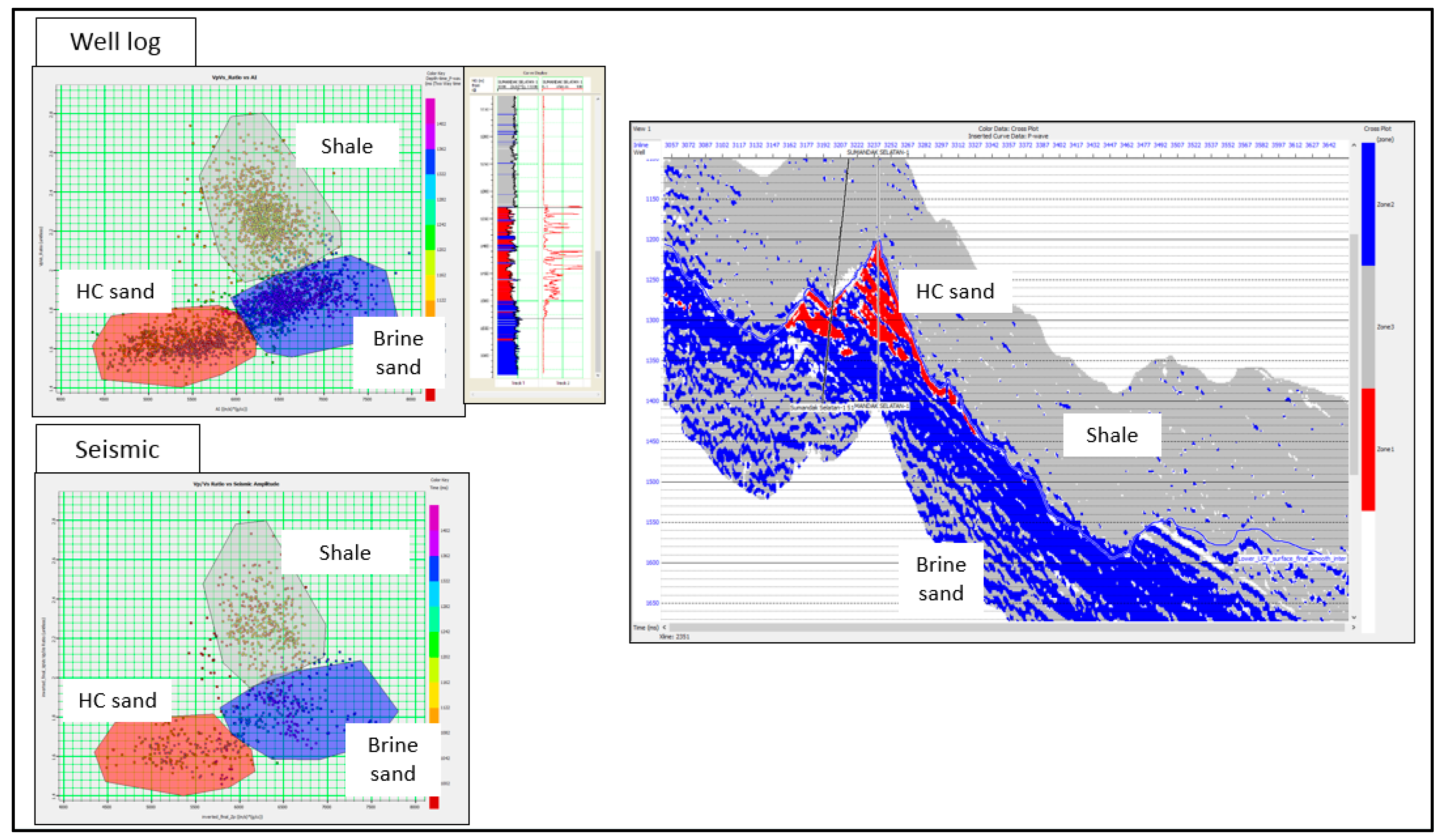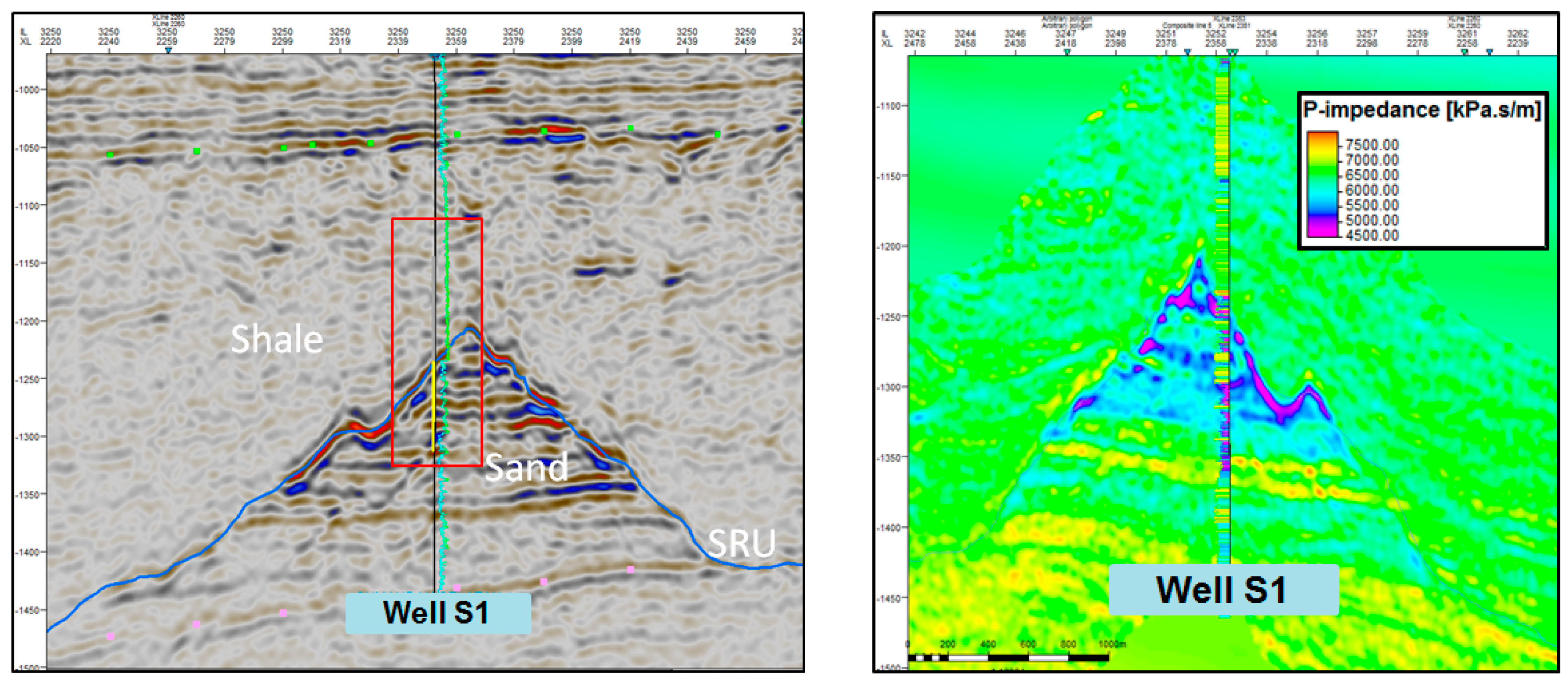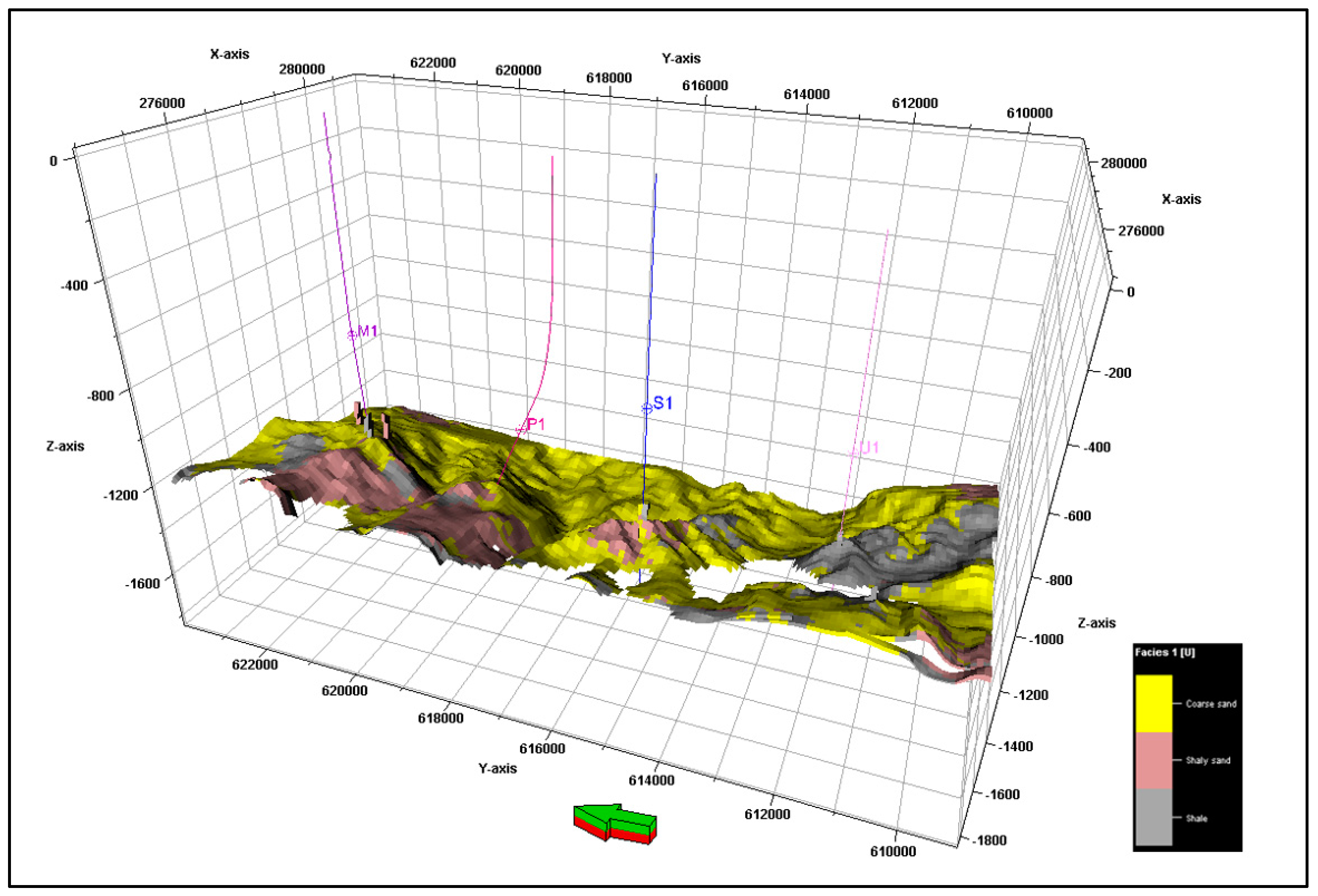1. Introduction
The X Field, which lies to northwest of the Southern Inboard Deformation Belt, is located in the outer shelf of the West Sabah Basin.
Figure 1 shows the simplified geological map of Sabah outlining the Neogene Basins and their sub-basins. The Sabah Basin is a structurally complex basin with 12 km thick Neogene sediments deposited within the deep marine and progradational shelf-slope environment [
1].
Figure 2 schematically shows the stratigraphy of several east–west tracts of the Sabah Basin. The sedimentary sequences of Sabah Basin are informally called “Stages”. The recognition of major unconformity-bounded sedimentary packages of Stages IVA (sedimentary sequence Stage IVA) to IVF (sedimentary sequence Stage IVF) resulted from its complex syn-tectonic sedimentary history [
2,
3]. Oil and gas exploration activities have been sparse in the Northeast Sabah Basin (
Figure 1), where minor discoveries were found in deltaic sandstones. Other targets within the basin include deep water fans and carbonate build-ups. Adequate knowledge on facies distribution and depositional environment is essential to delineate hydrocarbon potential. Facies analysis is able to provide some predictability to the facies distribution of the area of interest or between the data points (wells). A facies model is ideal for summarizing the sequence of facies within a specific depositional environment [
4]. Genetic description is advantageous, as it potentially adds some predictability to the analysis from the determination of the sedimentological controls over the geometry of facies and genetic associations with other facies. The interpretative description of facies may reflect a particular depositional process or depositional environment of a certain unit of strata.
Seismic and well log data are widely used for subsurface mapping, as they complement each other. Seismic data essentially provides information on the lateral extension and distribution of geological elements compared to wells or cores. They measure larger lateral areas between wells but with a limited vertical resolution compared to well data [
6]. They are useful in depicting the regional setting on a larger scale. Well logs yield a finer vertical resolution of the geology at the well locations. A well log is a chart that shows a concise and detailed plot of the formation parameters versus depth. Different lithologies, porosity of rocks, as well as the pay zones can be identified through the interpretation of logs.
Various classification algorithms have been adopted for facies classification, such as generalized boosted regression model (GBM) [
7], kernel support vector machines [
8], partitioning algorithms [
9], and neural networks [
10,
11]. These classification algorithms predict the discrete and continuous probability distribution of facies. The interpretation of different log data such as neutron porosity, shale volume, and water saturation was considered for lithofacies classification in these studies [
7,
8].
In this study, 3D seismic data will be used to characterize the stratigraphy and architecture of the depositional elements and infer the processes of deposition where appropriate. Representative and successive horizons will be selected and picked through the 3D seismic data. The horizons bear imprints of the geomorphological evolution of the area of interest. The well log interpretation includes gamma ray, neutron porosity, and water saturation, as a function of depth. Facies classification is a challenging task. It is significant for formation evaluation analysis and reservoir characterization. Its purpose is to distinctly define subsurface geology and build a better understanding of the depositional environment in the area. A facies model can be used for the construction of the depositional environment of the study area.
The proposed methodology will incorporate seismic information using a suitable range of seismic facies analysis techniques. The methodology should later be calibrated with seismic attributes for enhancement. Seismic attributes are used to assist interpretation at different scales, ranging from analyzing depositional systems to mapping detailed structures, stratigraphy, and rock properties. They enhance information that might be more subtle in the original seismic image to provide a better geological or geophysical interpretation. Depending on their geologic application, attributes are classified and categorized into three groups: (1) structural mapping and geomorphological identification, (2) resolution of thin beds and improving interpretability, and (3) porefill and lithology discrimination [
12].
2. Materials and Methods
The identification of the lithofacies is achieved by integrating well log and 3D seismic data. Well log analysis is carried out based on the geophysical logs from four different wells including gamma ray, resistivity, and sonic logs. Gamma ray and resistivity logs are useful for the identification of lithofacies and hydrocarbon-bearing zones. Gamma ray facies trends generally reflect changes in the proportion of sandstone to shale, which in turn are inferred to record changes in the depositional energy of high to low current flow. The logs are also used for well correlation and seismic-to-well tie. The classification of lithofacies requires the estimation of the lateral distribution of each lithofacies with relative confidence at the cored wells as well as the estimation of the lithofacies at the non-cored wells.
Seismic interpretation generally assumes that coherent events observed on the seismic sections are reflections from acoustic impedance contrasts. These contrasts are associated with features that represent different geological structures [
13]. Regions of differing seismic facies are delineated using descriptive terms that reflect large-scale seismic patterns, including reflection amplitude, continuity, and internal configuration of reflectors that is bounded by stratigraphic horizons. 3D seismic data could be useful in constructing images of depositional facies. In this study, the principle is to calibrate seismic response with geologic information at the well in order to extend prediction of the geology away from well locations.
Figure 3 shows the workflow for optimizing the analysis.
Once the lithofacies are identified through well log and seismic data analysis, Sequential Indicator Simulation (SIS) is adopted in this study to map the distribution of facies in the study area. SIS is a pixel-based simulation method used for stochastic modeling of nonparametric properties, such as rock types. The continuous variable is transformed into a number of indicator variables and these indicator variables will be spatially modeled using variogram or covariance functions [
14]. Indicator variograms characterize the spatial variations. SIS takes into account the spatial variation of observed data at the sampled locations and estimated variation at unsampled locations to create a facies model. Its conceptual simplicity and straightforwardness made the sequential algorithm one of the most widespread in geostatistical applications [
15]. Although legitimate criticisms arise against SIS, such as the models appear unstructured and the indicator variograms only control two-point statistical measures, there are some good reasons to consider the technique [
16]. The robust algorithm provides a straightforward way to transfer uncertainty in categories through to the resulting numerical models and the required parameters are easy to infer from inadequate data. SIS has also been widely studied and adopted in many other studies [
14,
16,
17].
3. Results
Well data including logs, cores, and thin sections are often used to relate rock parameters with seismic data. In this study, only geophysical logs from wells M1, P1, U1, and S1 are used due to the lack of other well data. Taking wells M1 and S1 as examples,
Figure 4 depicts the discrete lithofacies distribution (sand, shaly sand, and shale). The well log interpretation includes gamma ray, porosity, density, and water saturation, as a function of depth. Within the reservoir interval (1100 m to 1600 m), the amount of shale is low in well M1, whereas sandstone is high, and the amount of shale increases from well M1 towards well S1 as the amount of sandstone reduces. The shaly sequences were deposited as interlayers with sand bodies. The predicted percentage of the sand and shale/shaly sand distribution is 55.37% and 44.63%, respectively.
At well locations, cross-plot analysis of different parameters aids in the detection of zones with different lithologies. For example,
Figure 5 indicates the scatter points of shale, HC (hydrocarbon) sand, and brine sand of the reservoir interval based on the cross plot of acoustic impedance (AI) versus Vp/Vs ratio (Vp and Vs are velocities of primary wave and secondary wave, respectively; i.e., the compressional velocity and shear velocity). AI-Vp/Vs cross-plot can be useful for hydrocarbon detection. Vp/Vs parameter on inversion results can be used to distinguish different types of lithofacies.
According to the interpreted seismic section and geological setting of the area, two prominent facies are identified, namely sandstone and shale due to their distinct lithological variations.
Figure 6 shows the seismic section through Well S1 and the reservoir interval. Above the Shallow Regional Unconformity (SRU) are shale beds acting as reservoir seal. Shale is consistently found in all of the wells in X Field. Below the shale, high-amplitude reflections at the sandstone layer show the interface response of the hydrocarbon accumulations. The reflection within this interval has good continuity and high to moderate amplitude variation. The logs (gamma ray and porosity) show that at Well S1, the dominant lithofacies in the reservoir interval is sandstone. Referring to the stratigraphic scheme of Sabah Basin, the sequence above SRU is identified as Upper Miocene in age and categorized into Stage IVC.
Using Sequential Indicator Simulation (SIS), a facies model is produced by the mean of distributing discrete facies throughout the model grid. In this study, two fundamental facies types were determined in the X Field reservoir based on the well data input and the spatial distribution induced by trend models.
Figure 7 shows the facies model indicating the sand and shale distribution in the study area. Previous studies indicated that the area of interest is characterized by the East Baram Delta depositional environment (which includes deltaic, shelf, and slope sediments deposited in an overall progradational system from Middle Miocene to younger stages of Stage IVC (sedimentary sequence stage IVC) [
18].

